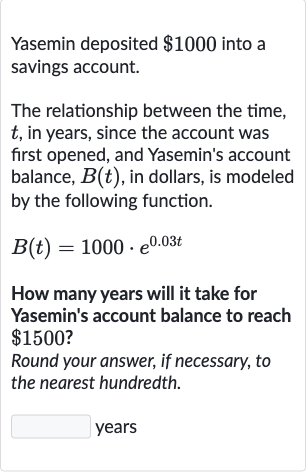AI tutor
Welcome to Bytelearn!
Let’s check out your problem:

Yasemin deposited into a savings account.The relationship between the time, , in years, since the account was first opened, and Yasemin's account balance, , in dollars, is modeled by the following function.How many years will it take for Yasemin's account balance to reach ?Round your answer, if necessary, to the nearest hundredth.years
Full solution
Q. Yasemin deposited into a savings account.The relationship between the time, , in years, since the account was first opened, and Yasemin's account balance, , in dollars, is modeled by the following function.How many years will it take for Yasemin's account balance to reach ?Round your answer, if necessary, to the nearest hundredth.years
- Given function and goal: We are given the function which models the account balance over time. We want to find the time when the account balance reaches . We can set up the equation and solve for .
- Isolating exponential term: First, we divide both sides of the equation by to isolate the exponential term on one side. This gives us .
- Simplifying equation: Simplifying the left side of the equation, we get .
- Taking natural logarithm: To solve for , we need to take the natural logarithm () of both sides of the equation because the inverse of the exponential function is the natural logarithm. This gives us .
- Solving for : Using the property of logarithms that , we can simplify the right side of the equation to . So we have .
- Calculating final value: To solve for , we divide both sides of the equation by . This gives us .
- Calculating final value: To solve for , we divide both sides of the equation by . This gives us .Now we calculate the value of using a calculator. The calculation is years when rounded to the nearest hundredth.
